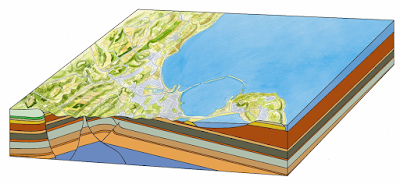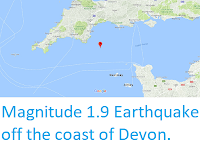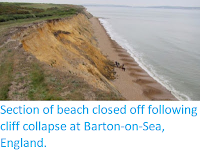A large sinkhole has opened up on Bronkham Hill near Dorchester in Dorset, England. The hole was first observed in February 2019, when it was the size of a dinner plate, prompting Dorset Council to call in a team of geologists, who concluded that the visible hole was located above a much larger void, and had the potential to open up to be about 30 m across and 15 m deep. This conclusion led to the closure of a coastal path which passed the hole. Since that time the hole has widened to the predicted size, and a safety barrier placed around it, though it is thought unlikely that the hole will grow any more, and the path has now been re-opened.
The Bronkham Hill sinkhole on 8 May 2019. Dorset Council.
Sinkholes
are generally caused by water eroding soft limestone or unconsolidated
deposits from beneath, causing a hole that works its way upwards and
eventually opening spectacularly at the surface. Where there are
unconsolidated deposits at the surface they can infill from the sides,
apparently swallowing objects at the surface, including people, without
trace.
(Top) Map of South Dorset showing the location of Bronkham Hill. Google Maps. (Bottom) North south cross-section and relief map of the same area. Holiday (2018).
Bronkham Hill forms a part of the South Dorset Ridgeway, a line of hills caused by a series of faults in the geology of the area (seen on the left in the cross-section above) which expose different rock layers at the surface, leading to different rates of erosion, and therefore different ground levels (hills and valleys). At Bronkham the hill is comprised largely of Cretaceous chalk (the white layer overlaying the green on the left in the cross-section), a soft, permeable limestone absent from the coastal exposures of the region, where harder Jurassic limestones make up the cliffs of the Jurassic Coast. This chalk is easily eroded by (slightly acidic) rainwater, opening up voids in the hillside, which form sinkholes. The area is also home to numerous ancient buried holes, formed by meltwater from glaciers filtering through the rock during the Pleistocene, which can lead to the rapid appearance of large sinkholes as holes formed by modern processes link up with these more ancient voids.
Old sinkholes on Bronkham Hill. Nigel Mykura/BBC.
See also...
Follow Sciency Thoughts on Facebook.










